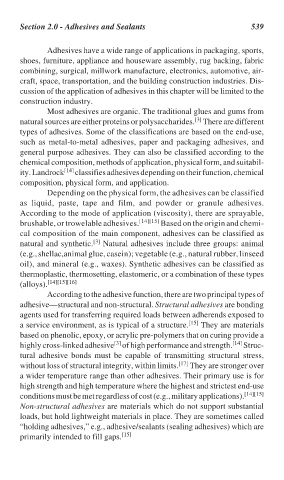Page 569 - Handbook of Thermal Analysis of Construction Materials
P. 569
Section 2.0 - Adhesives and Sealants 539
Adhesives have a wide range of applications in packaging, sports,
shoes, furniture, appliance and houseware assembly, rug backing, fabric
combining, surgical, millwork manufacture, electronics, automotive, air-
craft, space, transportation, and the building construction industries. Dis-
cussion of the application of adhesives in this chapter will be limited to the
construction industry.
Most adhesives are organic. The traditional glues and gums from
[3]
natural sources are either proteins or polysaccharides. There are different
types of adhesives. Some of the classifications are based on the end-use,
such as metal-to-metal adhesives, paper and packaging adhesives, and
general purpose adhesives. They can also be classified according to the
chemical composition, methods of application, physical form, and suitabil-
ity. Landrock [14] classifies adhesives depending on their function, chemical
composition, physical form, and application.
Depending on the physical form, the adhesives can be classified
as liquid, paste, tape and film, and powder or granule adhesives.
According to the mode of application (viscosity), there are sprayable,
brushable, or trowelable adhesives. [14][15] Based on the origin and chemi-
cal composition of the main component, adhesives can be classified as
[3]
natural and synthetic. Natural adhesives include three groups: animal
(e.g., shellac, animal glue, casein); vegetable (e.g., natural rubber, linseed
oil), and mineral (e.g., waxes). Synthetic adhesives can be classified as
thermoplastic, thermosetting, elastomeric, or a combination of these types
(alloys). [14][15][16]
According to the adhesive function, there are two principal types of
adhesive—structural and non-structural. Structural adhesives are bonding
agents used for transferring required loads between adherends exposed to
a service environment, as is typical of a structure. [15] They are materials
based on phenolic, epoxy, or acrylic pre-polymers that on curing provide a
[3]
highly cross-linked adhesive of high performance and strength. [14] Struc-
tural adhesive bonds must be capable of transmitting structural stress,
without loss of structural integrity, within limits. [17] They are stronger over
a wider temperature range than other adhesives. Their primary use is for
high strength and high temperature where the highest and strictest end-use
conditions must be met regardless of cost (e.g., military applications). [14][15]
Non-structural adhesives are materials which do not support substantial
loads, but hold lightweight materials in place. They are sometimes called
“holding adhesives,” e.g., adhesive/sealants (sealing adhesives) which are
primarily intended to fill gaps. [15]

